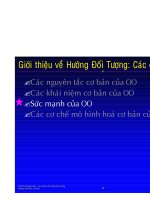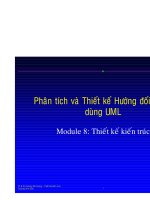Phân tích thiết kế hướng đối tượng (phần 10) pptx
Bạn đang xem bản rút gọn của tài liệu. Xem và tải ngay bản đầy đủ của tài liệu tại đây (1.09 MB, 14 trang )
Created by Trang Hồng Sơn
- 1 -
SEQUENCE DIAGRAM
1. Tổng quan:
- Sequence Diagram: là sơ ñồ mô tả sự tương tác giữa các ñối tượng theo hướng thời gian,
nhấn mạnh thứ tự thực hiện các tương tác.
: A myB : B
doTwo
doOne
doThree
public class A {
private B myB = new B();
public void doOne() {
myB.doTwo();
myB.doThree();
}
}
- Mối quan hệ giữa sơ ñồ tương tác và sơ ñồ lớp:
: Register : Sale
makePayment(cashTendered)
makePayment(cashTendered)
Register
makePayment(…)
Sale
makePayment(…)
1
currentSale
messages in interaction
diagrams indicate operations
in the class diagrams
classes
identified in the
interaction
diagrams are
declared in the
class diagrams
public class Register {
private Sale sale = new Sale();
public void makePayment(Money cashTendered) {
sale.makePayment(cashTendered);
}
}
Created by Trang Hồng Sơn
- 2 -
- Các ký hiệu chung:
sales:
ArrayList<Sale>
:Sale s1 : Sale
lifeline box representing an
instance of an ArrayList class,
parameterized (templatized) to
hold Sale objects
lifeline box representing an
unnamed instance of class Sale
lifeline box representing a
named instance
sales[ i ] : Sale
lifeline box representing
one instance of class Sale,
selected from the sales
ArrayList <Sale> collection
x : List
«metaclass»
Font
lifeline box representing the class
Font, or more precisely, that Font is
an instance of class Class – an
instance of a metaclass
related
example
List is an interface
in UML 1.x we could not use an
interface here, but in UML 2, this (or
an abstract class) is legal
+ Singleton Objects:
public class Register {
private Store store = Store.getInstance();
public void doX() {
store.doA();
}
}
+ Messages:
: Register : Sale
doA
doB
doX
doC
doD
typical sychronous message
shown with a filled-arrow line
a found message
whose sender will not
be specified
execution specification
bar indicates focus of
control
Created by Trang Hồng Sơn
- 3 -
+ Reply or Returns: 2 cách thể hiện
: Register : Sale
d1 = getDate
getDate
doX
aDate
public class Register {
private Sale sale = new Sale();
public void doX() {
Date d1 = sale.getDate();
}
}
+ Messages to "self" or "this":
: Register
doX
clear
public class Register {
public void doX(){
this.clear();
…
}
private void clear(){
}
}
+ Creation of Instances:
: Register : Sale
makePayment(cashTendered)
: Payment
create(cashTendered)
authorize
note that newly created
objects are placed at their
creation "height"
Created by Trang Hồng Sơn
- 4 -
public class Sale {
private Payment payment;
public void makePayment(Money cashTendered) {
payment = new Payment(cashTendered);
payment.authorize();
}
}
+ Object Destruction: các ngôn ngữ lập trình không hổ trợ “garbage collection”
: Sale
: Payment
create(cashTendered)
the «destroy» stereotyped
message, with the large
X and short lifeline
indicates explicit object
destruction
«destroy»
X
+ Looping construct:
enterItem(itemID, quantity)
: B
endSale
a UML loop
frame, with a
boolean guard
expression
description, total
makeNewSale
[ more items ]
loop
: A
+ Conditional Messages: 2 cách thể hiện
calculate
: Bar
yy
xx
[ color = red ]
opt
: Foo
[ color = red ] calculate
: Bar
yy
xx
: Foo
public class Foo {
private Bar bar = new Bar();
public void doX() {
bar.xx();
if (color.equals(“red”)) {
bar.calculate();
}
bar.yy();
Created by Trang Hồng Sơn
- 5 -
}
}
+ Mutually Exclusive Conditional Messages:
: B
: A
calculate
doX
: C
calculate
[ x < 10 ]
alt
[ else ]
public class A {
private B b = new B();
private C c = new C();
public void doX() {
if (x < 10) {
b.calculate();
} else {
c.calculate();
}
}
}
+ Iteration Over a Collection: 2 cách thể hiện
st = getSubtotal
lineItems[i] :
SalesLineItem
t = getTotal
[ i < lineItems.size ]
loop
: Sale
This lifeline box represents one
instance from a collection of many
SalesLineItem objects.
lineItems[i] is the expression to
select one element from the
collection of many
SalesLineItems; the ‘i” value
refers to the same “i” in the guard
in the LOOP frame
an action box may contain arbitrary language
statements (in this case, incrementing ‘i’)
it is placed over the lifeline to which it applies
i++
st = getSubtotal
lineItems[i] :
SalesLineItem
t = getTotal
loop
: Sale
Created by Trang Hồng Sơn
- 6 -
public class Sale {
private List<SalesLineItem> lineItems = new ArrayList<SalesLineItem>();
public Money getTotal() {
Money total = new Money();
Money subtotal = null;
for (SalesLineItem lineItem : lineItems) {
subtotal = lineItem.getSubtotal();
total.add( subtotal );
}
return total;
}
}
+ Nesting of Frames:
calculate
: Bar
xx
[ color = red ]
opt
: Foo
loop(n)
+ Reference Diagrams:
interaction occurrence
note it covers a set of lifelines
note that the sd frame it relates to
has the same lifelines: B and C
doA
: A : B : C
doB
sd AuthenticateUser
ref
AuthenticateUser
authenticate(id)
doX
doM1
: B : C
authenticate(id)
doM2
ref
DoFoo
sd DoFoo
doX
: B : C
doY
doZ
Created by Trang Hồng Sơn
- 7 -
+ Messages to Classes or Invoke Static Methods:
public class Foo {
public void doX() {
// static method call on class Calendar
Locale[] locales = Calendar.getAvailableLocales();
}
}
+ Polymorphic Messages and Cases:
:Register
authorize
doX
:Payment {abstract}
polymorphic message
object in role of abstract
superclass
:DebitPayment
doA
authorize
:Foo
stop at this point – don’t show any
further details for this message
doB
:CreditPayment
doX
authorize
:Bar
Payment {abstract}
authorize() {abstract}
CreditPayment
authorize()
DebitPayment
authorize()
Payment is an abstract
superclass, with concrete
subclasses that implement the
polymorphic authorize operation
separate diagrams for each polymorphic concrete case
Created by Trang Hồng Sơn
- 8 -
+ Asynchronous and Synchronous Calls:
public class ClockStarter {
public void startClock() {
Thread t = new Thread( new Clock() );
t.start(); // asynchronous call to the 'run' method on the Clock
System.runFinalization(); // example follow-on message
}
}
// objects should implement the Runnable interface, in Java to be used on new threads
public class Clock implements Runnable {
public void run() {
while (true) { // loop forever on own thread
}
}
}
Created by Trang Hồng Sơn
- 9 -
2. GRASP principles (General Responsibility Assignment Software Patterns)
: thiết kế
hướng trách nhiệm (Responsibility-Driven Design)
- “knowing” responsibility:
+ private encapsulated data
+ related objects
+ things it can derive or calculate
- “doing” responsibility:
+ take action (create an object, do a calculation)
+ initiate action in other objects
+ control / coordinate actions in other objects
- 5 nguyên lý cơ bản:
+
Controller
:
. Vấn ñề: ñối tượng nào ñứng sau UI layer ñể nhận sự tương tác của Actor và ñiều khiển
các hoạt ñộng của hệ thống ?
. Giải quyết:
- Facade controller: xử lý cho toàn bộ hệ thống, là ñối tượng root.
- Session controller: xử lý cho một use case cụ thể nào ñó.
. Ví dụ:
- ðối tượng nào ñiều khiển hoạt ñộng của game Monopoly ?
- Facade controller: ñối tượng root ? MonopolyGame.
Created by Trang Hồng Sơn
- 10 -
- Session controller: use case “PlayGame” PlayMonopolyGameHandler hoặc
PlayMonopolyGameSession.
+
Creator
:
. Vấn ñề: ñối tượng nào tạo ra ñối tượng A ?
. Giải quyết: ñối tượng B tạo ra ñối tượng A khi:
- B “contains” A (chứa)
- B records A (ghi nhận)
- B closely uses A (sử dụng)
- B has the initializing data for A (khởi tạo dữ liệu)
. Ví dụ:
- ðối tượng nào tạo ñối tượng Square ? Board.
Created by Trang Hồng Sơn
- 11 -
+
Information Expert
:
. Vấn ñề: ñối tượng nào nắm giữ thông tin của ñối tượng A ?
. Giải quyết: bổ sung thao tác lấy thông tin.
. Ví dụ:
- ðối tượng nào nắm giữ thông tin về ñối tượng Square ? Board.
+
Low Coupling
:
. Vấn ñề: làm sao ñể giảm sự ảnh hưởng khi có sự thay ñổi, nói cách khác là giảm sự móc
nối, sự phụ thuộc lẫn nhau ?
. Giải quyết: số lần gọi hàm ñến ñối tượng khác là ít nhất có thể.
. Ví dụ:
public class A {
public void doX() {
Square s = new Dog().getSquare("aaa");
}
}
public class Dog {
public void getSquare(String name) {
Map<Square> squares = new Board().getAllSquares();
Created by Trang Hồng Sơn
- 12 -
return squares.get(name);
}
}
public class A {
public void doX() {
Square s = new Board().getSquare("aaa");
}
}
+
High Cohesion
:
. Vấn ñề: làm sao ñể ñưa các thao tác vào ñúng trách nhiệm của các ñối tượng ?
. Giải quyết: phân rõ trách nhiệm của từng ñối tượng cụ thể.
. Ví dụ: trách nhiệm của MonopolyGame là Controller (ñiều khiển, ñiều hướng hoạt ñộng,
chứ không phải giải quyết, thực thi các thao tác cụ thể nào ñó).
Created by Trang Hồng Sơn
- 13 -
3. Case study “Hệ thống thư viện ñiện tử”:
- Use Case “ðăng nhập”:
: Thu Thu
: FormChinh
: FormDangNhap
: CtrlDangNhap
: Thuthu
1: Yeu cau dang nhap
2: Load form DangNhap
3: Nhap thong tin dang nhap (username, password)
4: Boolean := authorize(username, password)
5: Boolean := check(username, password)
6: True
7: True
8: Chuyen den trang quan ly
- Use Case “Tra cứu sách”:
: Ban Doc
: FormChinh : FormTraCuuSach
: CtrlTraCuuSach
: Sach
1: Yeu cau tra cuu sach
2: Load form TraCuuSach
3: Nhap thong tin tra cuu (tuKhoa, tieuChi)
4: ArrayList := searchBook(tuKhoa, tieuChi)
5: ArrayList := search(tuKhoa,tieuChi)
6: Danh sach ket qua tim kiem
7: Danh sach ket qua tim kiem
8: Danh sach cac quyen sach tim duoc
9: Chon mot quyen sach
10: Sach := getBook(maSach)
11: Sach := get(maSach)
12: Sach
13: Sach
14: Thong tin chi tiet sach
Created by Trang Hồng Sơn
- 14 -
- Use Case “Thêm sách”:
: Thu Thu
: FormChinh : FormThemSach
: CtrlThemSach
: Sach
1: Yeu cau them sach
3: Nhap thong tin sach moi
9: Thong bao them sach thanh cong
4: Boolean := insertBook(thongTinSach)
8: True
6: [ validate = True ] Boolean := insert(thongTinSach)
7: True
5: Boolean := validate(thongTinSach)
2: Load form ThemSach









